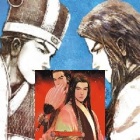I suppose longtime readers of Ravages already know about the bumps and bruises in the English scanlation scene, or the author’s shift from a weekly release to a biweekly and now sometimes triweekly release due to family life and maturing age.
With regard to the scanlation, here’s a partial recap for the newbies: some scanlation group took up the project of introducing Ravages to the English-speaking part of the internet and released decent enough chapters with clumsy translation, but then things happened and so some remnant members of that group decided to continue scanning until they stopped and some guy took up the mantle by providing low-quality scans and edits before the golden age of the best scanlator churning out high-quality chapters almost on a daily basis only for that to end as well, and now we are in the predicament where some rather busy Indonesian scanlator barely editing the already-substandard Chinese source scans and releasing the chapters on an erratic schedule is pretty much the only relatively consistent one left to release the English scans.
Not that I blame the ones involved; in fact I’m really grateful that there are still English scans of Ravages to begin with. 🙂
Of course, the main unofficial translator has been in the game since around the tenth volume, and now we have reached volume 57 as of the day of my posting this.
It’s also possible that the Chinese scans themselves suffered a decline, and that there are fewer attempts at cleanly scanning the volume versions of Ravages nowadays.
I don’t have much to say about scanlation attempts in other languages like Portuguese and Vietnamese though.
Speaking of which, I almost forgot to mention that Ravages had official translations into other languages including Japanese, but sadly those efforts did not last long.
Having said all these introductory matters, what I really want to talk about is how Ravages was ravaged by time, in other words the shifts and successions in the style and tone of the series in its fifteen years of stubborn persistence.
But before that, some intermission music, yay.
I non-canonically divide the first 55 volumes of Ravages into roughly three main development stages, as it were.
The early stage spans the first five volumes, where the art style is still a bit goofy, the chapter titles aren’t as well crafted, the action scenes at times can be very over-the-top, the focus is still on the Handicapped Warriors, wuxia and sentai elements are more pronounced, more humor is woven into the interactions, and the scheming while already present tends to be wacky and has the vibe of an exciting thriller rather than a cold-blooded conspiracy.
More importantly though, the early stage contains more smiles and naivete and idealism, made most manifest in the scenes involving Liu Bei and his brothers.
Also thing to note is how the first five volumes are paced somewhat rapidly, with characters being introduced early in advance as if Ravages doesn’t have much time left before it ends.
And come to think of it, had Ravages omitted the dream scene and truly ended with the successful rescue of Sima Lang, the whole thing would still feel somewhat whole.
It may be because at this point the author is still being experimental and gauging audience responses without the guarantee of a lasting serialization run, and so he had to cram as many things as he could and use a more gimmicky approach to attract enough attention…
Or it could be that the author planned to use all of that as bait, and after having secured a positive response from the early fans particularly on the mind games, he was now ready to make a switch.
Enter the transition stage, which I estimate to consist of the next ten volumes.
Here the art style begins to shift toward the more serious albeit still stylized form that we see today, the action scenes and the humor are played down somewhat, the schemes become more convoluted and treacherous, the Handicapped Warriors while still involved in the goings-on step back a bit as more characters enter the scene, the story itself now dovetails more closely but in a twisty fashion to the major events in the novel and the historical record, and the mood as it were darkens.
More importantly, some of the early major characters change as their idealism fades away and/or their more self-serving ambitions become more pronounced.
It’s also possible to further divide this stage into two sub-stages, with volumes 6-10 still being relatively close to volumes 1-5 in terms of art style and story line, and with volumes 11-15 taking a big step by shifting attention to Cao Cao and Liu Bei.
After 125 chapters, the mature stage with sub-stages of its own that I won’t get into begins at volume 16 and continues up to this day.
The convoluted ruses and manipulations take center stage, the art style now more resembles or befits that of a solid graphic novel rather than a frivolous comic, action scenes aren’t as extended or hyperbolic but are now more beautifully crafted, the topics brought up in dialogues, monologues, or disembodied author commentaries become more ponderous and poetic, the chapter titles more closely follow the 4-character idiom format, the world has since expanded to feature warlords all over the place although the stories of Sima Yi and Liaoyuan Huo remain pivotal, and the warfare is now very meticulous even if the formations and the actual battle scenes tend to be a bit impressionistic.
More importantly, dramatic scenes become a mainstay as more characters suffer and die, complete with cheesy B-movie closeups and poses.
And by then, the heartfelt smiles and laughter of the early chapters are mostly replaced by confident smirks and mendacious grins, if not outright tears, nostalgia, and melancholia.
That’s pretty much all I have to say.
Enjoy Ravages!

